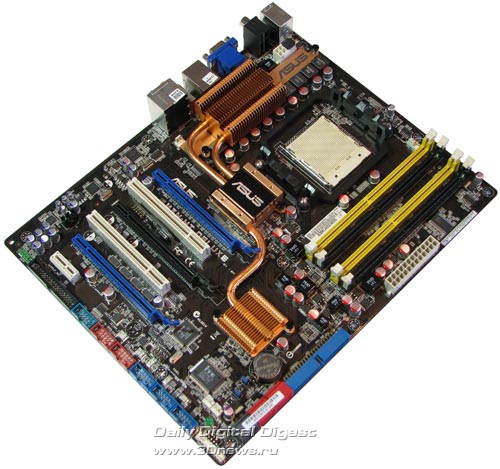| 3DNews Vendor Reference English Resource - All you need to know about your products! |
|
||||||||
 |
|||||||||
|
After quite a long while, the market has seen first motherboards based on new-generation NVIDIA chipsets for AMD processors. The most interesting products are motherboards built on the top-end nForce 780a chipset. The major trait of this chipset is that albeit comprising two chips, the second one is not a "south bridge"! The first and the major chip (780a SLI) includes the PCI Express bus controller, "south bridge" features, as well as the integrated graphic core GeForce 8400. The second chip is the well-known nForce 200 "bridge" which is aimed at implementation of additional PCI Express v2.0 lanes. Due to this "bridge", the chipset supports 35 PCI-E bus lanes, which allows setting up an SLI system with two (16+16) or three video cards (following the 8+8+8 scheme).  The focus in expansion options of the new chipset has somehow changed as compared to the nForce 590 SLI. In particular, the number of USB 2.0 ports has gone up from 10 to 12, with the number of Gigabit LAN controllers gone down from two to one. The remaining specifications remained unchanged: audio HD subsystem, five PCI slots, six SATA II links (supported is RAID 0,1,0+1,5), and one IDE link (with the option to plug in two devices). The pack of proprietary technologies has not changed (but for some minor improvements): MediaSheild, FirstPacket, support for the NVIDIA nTune. Now a few words on the integrated graphic core GeForce 8400.  To start with, at speed and functionality that is a rather powerful and interesting core which offers support for NVIDIA PureVideo HD, DirectX 10.0, HDMI, and HDCP. Besides, nForce 780a implements a really attractive Hybrid SLI technology which offers two important features: GeForce Boost, and HybridPower. The former is an analog to the Hybrid CrossFire and is aimed at value systems. Its idea is simple: if the user installs a value external video card (GeForce 8500 GT or GeForce 8400 GS) and enables the GeForce Boost, the computational resources of the external video card and the integrated video core are consolidated. Due to that, the user gets some speed gain in 3D applications. The latter feature (HybridPower) is a tribute to modern fashion for power-saving. Assume that the user has a high-end system with two or three video cards merged into an SLI array. That results in an unparalleled high speed in the most advanced games and 3D applications. But once the user quits Crysis and launches a web browser (or solitaire), all these powerful video cards put quite a high load uselessly, thus adding to the electricity bills. This situation is fixed by the HybridPower feature which seamlessly disables all the external video cards thus switching the load to the integrated video core. ASUS M3N-HT Deluxe Mempipe Specifications
PackageThe board is packaged in a rather impressive box of stylish design:  Package bundleThe package bundle includes the following items:
The most interesting of the bundled items is the system for cooling memory modules, named MemPipe.  Most of the other items are standard. These are a user's manual, a DVD with drivers, utilities, and third-party software,  a kit of cables, a bracket for a FireWire and two USB ports. We also note a cap for the rear panel of the board in the package bundle (with noise-vibration-proof coating).  Among the non-standard items, there is an additional rotor fan and an HDMI=>DVI adapter.  We also note that the board offers all the required "bridges" to set up SLI arrays for two and three video cards. |
||||||||||||||||||||||||||||||||||||||||
Management by AK Design VisualPharm.com |
|
|||





